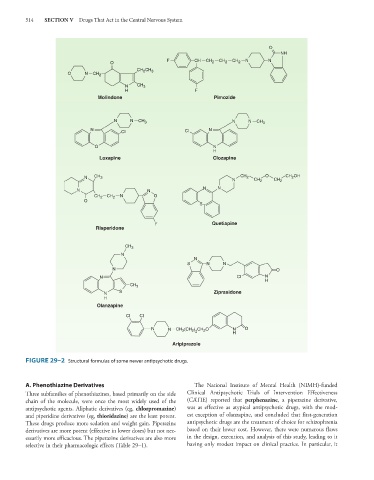Page 528 - Basic _ Clinical Pharmacology ( PDFDrive )
P. 528
514 SECTION V Drugs That Act in the Central Nervous System
O
NH
O F CH CH 2 CH 2 CH 2 N N
CH CH 3
2
O N CH 2
N CH 3
H F
Molindone Pimozide
N N CH 3 N N CH 3
N CI CI N
O N
H
Loxapine Clozapine
2
N CH 3 CH 2 O CH OH
N CH 2 CH 2
N N N N
CH 2 CH 2 N O
O
S
F Quetiapine
Risperidone
CH 3
N
N
S N N
N O
N Cl N
H
CH 3
N S Ziprasidone
H
Olanzapine
CI CI
N N CH 2 (CH ) CH O N O
2
2 2
H
Aripiprazole
FIGURE 29–2 Structural formulas of some newer antipsychotic drugs.
A. Phenothiazine Derivatives The National Institute of Mental Health (NIMH)-funded
Three subfamilies of phenothiazines, based primarily on the side Clinical Antipsychotic Trials of Intervention Effectiveness
chain of the molecule, were once the most widely used of the (CATIE) reported that perphenazine, a piperazine derivative,
antipsychotic agents. Aliphatic derivatives (eg, chlorpromazine) was as effective as atypical antipsychotic drugs, with the mod-
and piperidine derivatives (eg, thioridazine) are the least potent. est exception of olanzapine, and concluded that first-generation
These drugs produce more sedation and weight gain. Piperazine antipsychotic drugs are the treatment of choice for schizophrenia
derivatives are more potent (effective in lower doses) but not nec- based on their lower cost. However, there were numerous flaws
essarily more efficacious. The piperazine derivatives are also more in the design, execution, and analysis of this study, leading to it
selective in their pharmacologic effects (Table 29–1). having only modest impact on clinical practice. In particular, it

